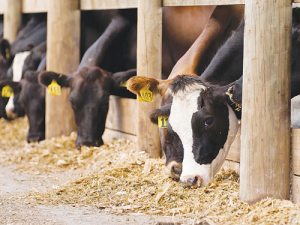As happens every season, the results beginning to come out of the feed testing labs are variable, however the vast majority of samples appear to have high starch, high drymatter and high digestibility figures.
As a result, we are seeing a lot of maize silage samples with energy figures in the mid 11 MJME/kgDM range. This is about 0.5 - 1.0 mjme/kgDM higher than we would see in an average season. With this in mind, farmers need to consider making the following changes to their feed plans:
1. Measure how much maize silage you are feeding.
The high drymatter (DM) and grain content means there is likely to be more maize silage in a tractor bucket or feed-out wagon than usual. An easy way to estimate weight is to put a few bucket-loads on the back of a ute and take it across a weighbridge. Send a sample for a DM analysis to work out the dry weight per bucket-load.
2. Begin feeding your maize silage gradually.
Our recommendation, for farmers introducing maize silage to pasture fed cows is to start feeding 1-2 kgDM/cow/day initially and then increase feeding by 1 kgDM/cow daily or every second day. In the past many farmers thought we were being too conservative as they were quickly feeding lots of maize with very little negative impact. However, that was with maize with 30% starch and 10.8 mjme/kgDM. This season’s maize is generally of much higher quality and so it is important that farmers introduce maize silage along the guidelines I mentioned above.
3. Calculate how much maize the cows are getting in one feed and split-feed earlier if needed.
To avoid feeding too much starch in one feed and therefore reduce the risk of cows getting acidosis, we have historically recommended that once cows are getting more than 5-6 kgDM in one feed, maize silage needs to be offered in two feeds/day. With this season’s high starch maize silage, consider making the split at 4-5 kgDM/cow/day.
4. Revise how much feed per cow you need to put on one body condition score (BCS).
It is widely accepted that maize silage is a great feed for putting weight on cows and many farmers use maize silage to achieve their BCS targets. A study done by DairyNZ1. in 2010 showed that, depending on size, cows require 130 - 180kgDM maize silage/cow to put on one body condition score. This number was based on maize silage at 10.5 mjme/kgDM. If your maize silage is 11.5 MJME/kgDM, then you will need about 10% less maize to put on the same amount of body condition.
5. Keep some maize silage for spring
At 11.5 MJME/kgDM, maize will be a perfect feed for spring. Not only will the high-energy feed fully complement pasture, but it will be perfect for filling the feed deficit that usually seems to occur on many farms in late August/early September. Because maize silage is a forage, farmers can use it to manipulate pasture supply. This means that when cows are leaving behind less than 1500kgDM/ha of pasture, maize can be used to fill the feed deficit and yet still supply energy to keep cows milking well.
For farmers in the lower North Island or the South Island who have wintered cows on fodder beet, maize silage is a great feed to transition cows off beet back onto pasture. It is also a great carrier for calcium and magnesium.
1. Facts and Figures for New Zealand Dairy Farmers, 2017. P52 . DairyNZ
• Ian Williams is a Pioneer forage specialist. Contact him at This email address is being protected from spambots. You need JavaScript enabled to view it.
















